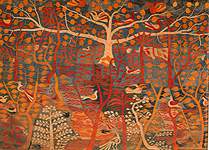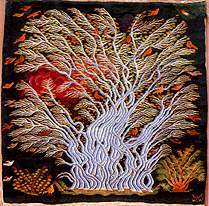|
EXPERIMENT IN CREATIVITY
"Human freedom never has as much
meaning and value as when it allows the creative power of
the child to come into action. All children are endowed with
a creative power which includes an astonishing variety of
potentialities. This power is necessary for the child to build
up his own existence."
In this brief statement, the late Ramses Wissa Wassef eloquently
sums up what was for him and still is today at the heart of
his unique artistic experiment. The village of Harrania, not
far from the ancient Pyramids of Giza, has for over a number
of years been the setting of this remarkable undertaking.
There, Ramses Wissa Wassef, architect, potter, weaver and
designer, set up a tapestry workshop to be used by the local
village children. With neither formal education nor artistic
training the children of Harrania were to become an important
part of his ongoing experiment. They would be introduced to
the craft and guided from then on in a rather extraordinary
way.
To begin with, all the weaving had to be done without the
aid of any sketch or design. Even the most complicated pieces,
which took many months to complete, were improvised on the
loom and arose from everyday-life impressions. Ramses Wissa
Wassef believed that in spite of all risks, a work of art
had to be conceived and executed directly in its material.
To depend on a design was a roundabout method which dissociated
and weakened the act of artistic creation. Here Ramses describes
the importance of this method.
"The continuous effort of working with
the material leads to a constant change in the work of these
young artists. The free play of their creative power starts
at the mysterious moment when the child seizes instinctively,
and in a flash of joy, the idea for the picture that he or
she intends to weave."
|

Tree
of life - 1955
|
To better understand how the tapestries were created, it
is important to consider the role played by both Ramses and
his wife Sophie. "A work of art,"
Ramses once wrote, "is similar to an
address. It happened that we were for these children persons
to whom they addressed themselves through the medium of their
work and we have been able to seize their expression and intention.
This role was neither forced nor exclusive, but was played
with affection and comprehension."
For Ramses, hand-weaving was at one time a highly expressive
and pure art which was quickly losing ground to machine production.
It was his hope to revive the fine sensibility of the craft
by making a fresh start with a group of children and simple
looms, proceeding, as he put it,"as slowly as may be, so as
to give wide scope for the play of deep, natural impulses."
|

|
As revealed through the statement which began this introduction,
Ramses' main concern rested with the child's individual potential.
Modern society he felt, more than ever, was concerned with
the population in mass, giving less attention to the individual.
In the following passage he details this point.
 Sycamore
-
1945
Sycamore
-
1945 |
"Modern society only promotes impersonal
and interchangeable talent which conforms to a certain set
of norms. In spite of all this, sometimes the profound accent
of a creative artist bursts out. But unfortunately, the world
stands dumb for a long time... We have never tired of listening
to these children. They have proved that they all possess
the creative spirit."
Indeed it is so, for the results are clearly revealed through
the excellence of the tapestries produced at the center. Since
Ramses' death in 1974, Sophie Wissa Wassef and her two daughters,
Suzanne and Yoanna, have energetically carried on the experiment
- an endeavor still flourishing to this day. At present, approximately
one hundred individuals are employed at the center, including
adults, adolescents and children.
Out of the fourteen weavers who began with Ramses and Sophie
40 years ago, twelve are still actively weaving. Ranging from
the ages of forty-five to fifty, they continue to work with
Sophie as their guide and inspiration. In a separate part
of the center, Suzanne continues her work with the second
generation wool weavers, a personal project she took on in
1973. She is also responsible for the production of stoneware
ceramics which she herself makes and designs. Her sister Yoanna
Wissa Wassef on the other hand, has taken charge of batik
and fine cotton weaving.
Although the center has expanded since its first days in
the 1950's, the same spirit and philosophy remains alive.
There, in a most impressive setting, the elements appearing
in the tapestries spring to life. As one enters the main gate,
on the left and facing west towards the edge of the valley,
one finds a museum designed by Ramses housing a collection
of ceramic sculptures. Looking to the right, one discovers
the workshops and galleries for finished work.
The Wissa Wassef family also have their homes here - their
vaults and domes a familiar silhouette against the evening
sky. These structures are surrounded by a spacious garden
with a large variety of plants and trees. One part of the
garden is entirely devoted to plants strictly grown for making
dyes. At the north edge of the garden is the large dome and
vault museum completed in 1989. It houses the permanent Wissa
Wassef collection and shows the development of the tapestries
since the early days of the experiment. Looking off into the
distance and across the fields and dessert, the statuesque
pyramids of Giza complete this sublime picture. It is here,
in just this setting, with the seeds that Ramses planted some
40 years ago, that the 'experiment
in creativity' continues to blossom with each new
season.
|
|